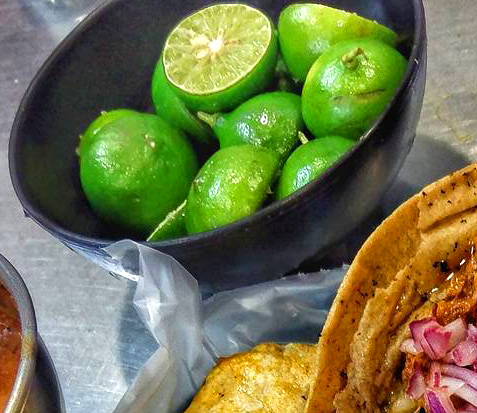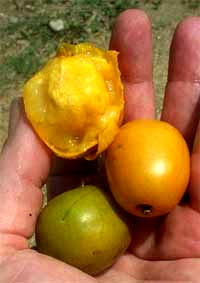
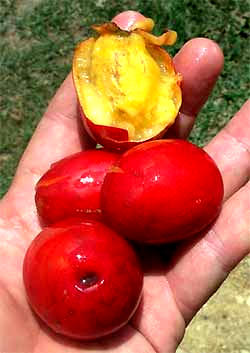 Known in English as Red Mombin and Hog Plum, jocotes are red or yellow-orange tree fruits, produced by Spondias purpurea of the Cashew Family, which is native to tropical America. Often jocotes are eaten raw but Mexicans also like to mash them in water, add sugar, and drink the water like Kool-Aid. They are 1-2 inches (2.5-5 cm) long. Jocotes come in red or yellow varieties. Spanish Plum fruits look and taste a lot like northern plums but are not closely related to them. Note the large, white, very hard, boxy seed, which is unlike the northern plum's pit. After growing on leafless tree limbs for months, the fruits ripen at the end of the dry season, in June or so. They are good raw and also make tasty preserves
Known in English as Red Mombin and Hog Plum, jocotes are red or yellow-orange tree fruits, produced by Spondias purpurea of the Cashew Family, which is native to tropical America. Often jocotes are eaten raw but Mexicans also like to mash them in water, add sugar, and drink the water like Kool-Aid. They are 1-2 inches (2.5-5 cm) long. Jocotes come in red or yellow varieties. Spanish Plum fruits look and taste a lot like northern plums but are not closely related to them. Note the large, white, very hard, boxy seed, which is unlike the northern plum's pit. After growing on leafless tree limbs for months, the fruits ripen at the end of the dry season, in June or so. They are good raw and also make tasty preserves
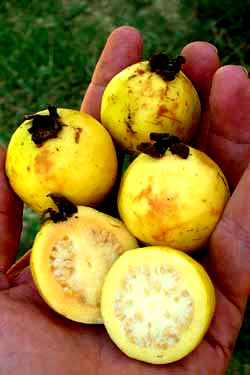 Known in English as guavas, are musky-flavored, soft-pulped fruits produced on small trees, Psidium guajava of the Myrtle Family, and native to tropical America. Guavas come in a huge variety of shapes, sizes (1-4 inches long, 2.5-10 cm), and tastes, but most in Mexico have yellow (maybe white or brownish) skins.
Known in English as guavas, are musky-flavored, soft-pulped fruits produced on small trees, Psidium guajava of the Myrtle Family, and native to tropical America. Guavas come in a huge variety of shapes, sizes (1-4 inches long, 2.5-10 cm), and tastes, but most in Mexico have yellow (maybe white or brownish) skins.
Notice their slightly rough skins and atop each fruit there's a puckered-out place bearing the remains of the flower's calyx. These "persistent calyx lobes" help us distinguish guavas from other medium-size, yellow fruits.
Guavas are an acquired taste. Many think that guava-flavored ice cream tastes better than the actual guava fruits. Also, many small, hard seeds are embedded in the flesh and generally are just swallowed. However, if you bite down too hard on one, you can break a tooth, so chew softly as if expecting a sand grain.
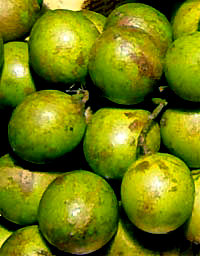 Guayas are sometimes called Spanish Lime, Genip, Mamoncillo and Grosella de Miel. In the Yucatán Spanish speakers often refer to them as Guaya Cubano, or "Cuban Guaya," for there is a native Guaya with smaller fruits. The main Guaya found in markets is from the fair-sized tree Melicoccus bijugatus of the Soapberry Berry. The fruits are about 1 inch (2.5 cm) in diameter containing a single large, round seed, which is sometimes roasted like a chestnut. The seed is surrounded by a yellowish, translucent, sweet/sour, juicy pulp. Juice from the pulp is used for flavoring drinks. A Guaya fan writes:
Guayas are sometimes called Spanish Lime, Genip, Mamoncillo and Grosella de Miel. In the Yucatán Spanish speakers often refer to them as Guaya Cubano, or "Cuban Guaya," for there is a native Guaya with smaller fruits. The main Guaya found in markets is from the fair-sized tree Melicoccus bijugatus of the Soapberry Berry. The fruits are about 1 inch (2.5 cm) in diameter containing a single large, round seed, which is sometimes roasted like a chestnut. The seed is surrounded by a yellowish, translucent, sweet/sour, juicy pulp. Juice from the pulp is used for flavoring drinks. A Guaya fan writes:
Bundles of guaya are sold by street vendors. The best way to eat them is frozen. Just pop a bunch in the freezer and wait a bit. With a bit of a tear the husky skin pops right off and the whole fruit can be popped in the mouth. It is so astringent and fresh it is like eating a guilt-free fireball. The only drawback to them is that the juice will permanently stain clothing."
The plant is native to the West Indies, Central and South America.
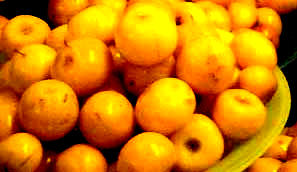 "Golden Spoon" and "Nance" in English, nanche fruits are produced by the tree Byrsonima crassifolia, of the Malpighia Family, native to tropical America. Notice that they are different from guavas in that their skin is shinier and their attached stems more slender. These fruits are so acid that most Northerners don't care for them. They're eaten raw and occasionally added to soups and meat stuffings.
"Golden Spoon" and "Nance" in English, nanche fruits are produced by the tree Byrsonima crassifolia, of the Malpighia Family, native to tropical America. Notice that they are different from guavas in that their skin is shinier and their attached stems more slender. These fruits are so acid that most Northerners don't care for them. They're eaten raw and occasionally added to soups and meat stuffings.
